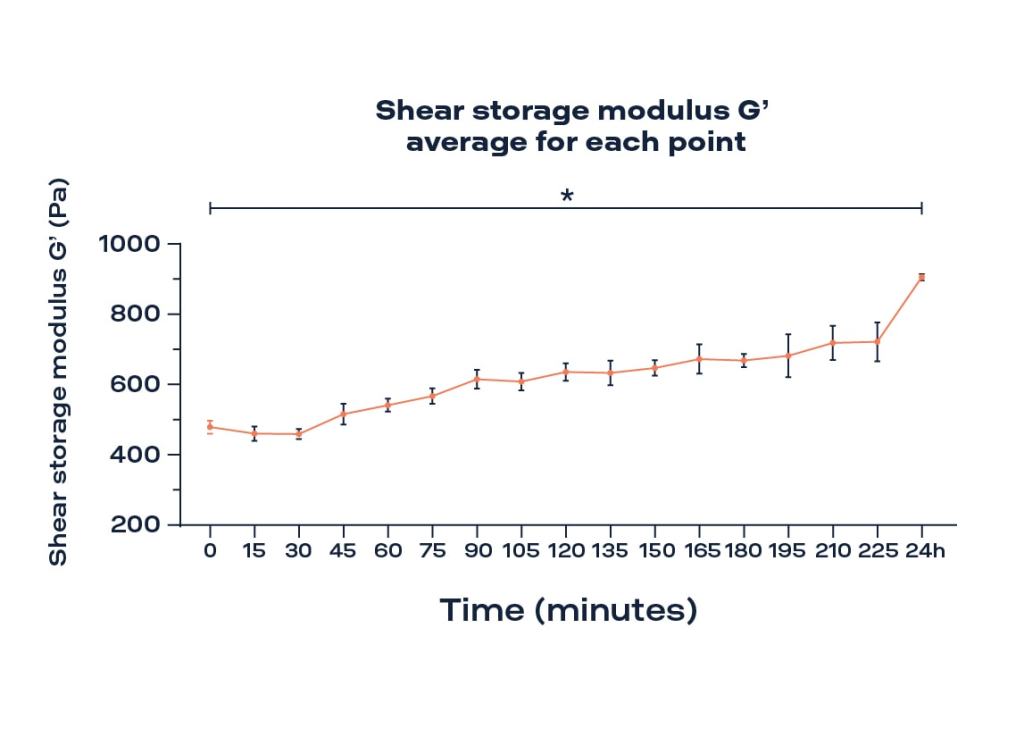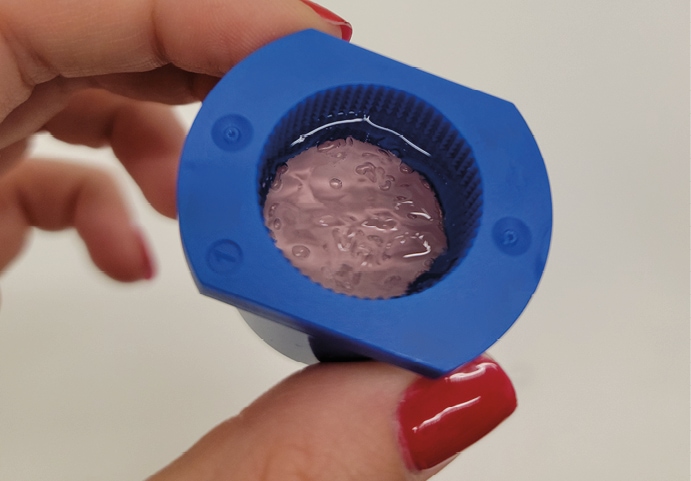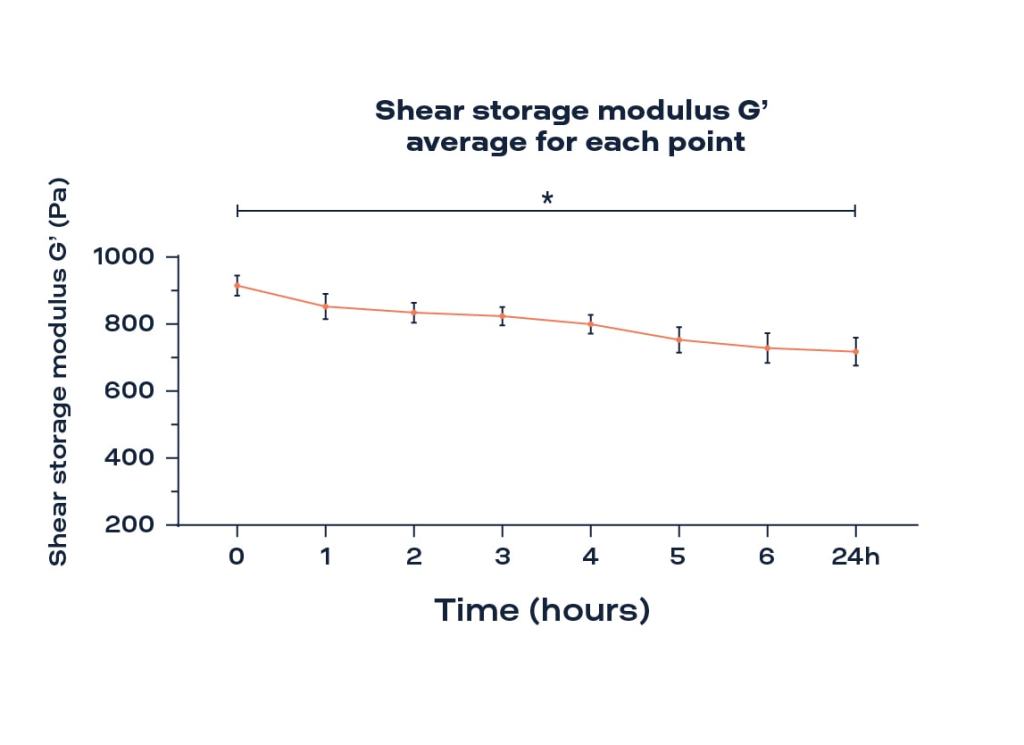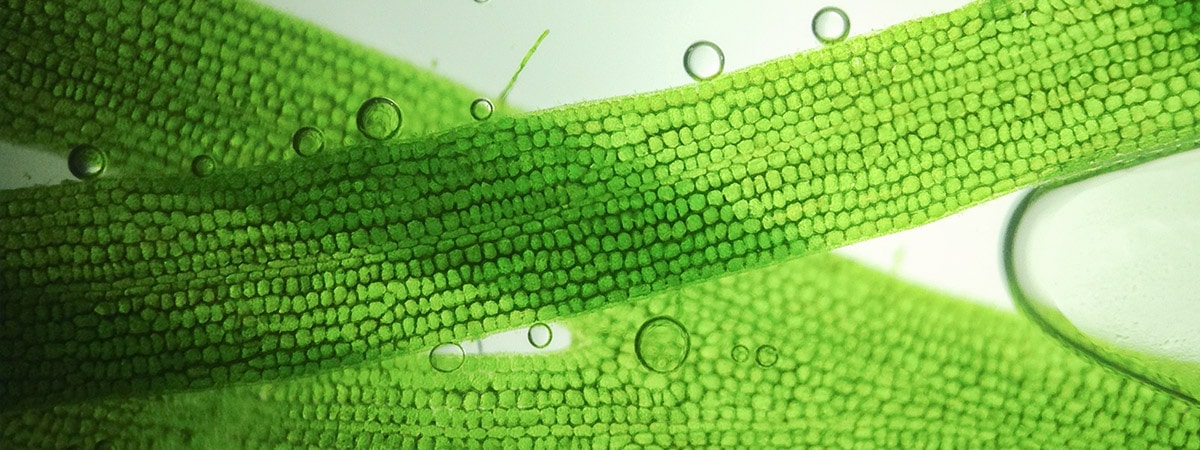Application note | Elastosens™ Bio
In collaboration with
Viscoelasticity characterization of Cellink alginate gels using ElastoSens™ Bio
NOTICE
This study results from a joint collaboration between Rheolution (Montreal, QC, Canada) and CELLINK (Boston, MA, USA).
SUMMARY
- Alginate is a natural biomaterial obtained from algae widely used for cell and protein delivery, and tissue engineering applications.
- Alginate quickly crosslinks in the presence of multivalent cations (e.g., Ca2+) in aqueous solutions resulting in a hydrogel with tunable mechanical properties.
- The lowest concentration of the calcium chloride solution provoked swelling and led to a slower crosslinking of the alginate gels.
- The higher concentration of the calcium chloride solution offered a fast crosslinking resulting in the shrinking of the alginate gels.
- The higher concentration of the calcium chloride solution led to stiffer alginate gels.
- Alginate hydrogels can dissolve once incubated in a saline solution without calcium chloride (e.g., PBS).
INTRODUCTION
Alginate is a polysaccharide present as a structural component of algae and a capsular component of soil bacteria. The polysaccharide is typically obtained from brown seaweed and used in many industries such as medical, pharmaceutical, food, textile due to its viscosifying, gelling and stabilizing properties. Alginate can quickly crosslink in the presence of multivalent cations (e.g., Ca2+) in aqueous solutions resulting in a hydrogel with tunable mechanical properties. This simple and cost-effective process and its ability to retain large quantities of liquid make alginate a valuable biomaterial for biotechnology applications such as drug and cell delivery and tissue engineering [1].
Alginate hydrogels can be injected in the body or implanted in a preformed shape. For the latter case, alginate has been frequently processed using extrusion-based 3D printing which requires a fast gelation process. The polysaccharide offers fast gelling in mild conditions (when mixed with multivalent cations) and in this way, cells can be easily and quickly encapsulated [2].
The viscoelastic properties of alginate can be tuned by changing different parameters such as polymer concentration and molecular weight, and type and concentration of the crosslinking agent. In this application note, 1% alginate from CELLINK was crosslinked with calcium chloride (CaCl2) solution at different concentrations (10 mM and 50 mM) and its viscoelastic properties were measured in the ElastoSens™ Bio after successive incubations with the solution. In addition, the mechanical stability of one crosslinked alginate formulation (10 mM) was evaluated over 24 hours under the incubation with a saline solution (PBS).
MATERIALS AND METHODS
Alginate 1% and CaCl2 solutions (10 mM and 50 mM) were obtained from CELLINK (Boston, USA). 3 mL of alginate was poured in the ElastoSens™ Bio’s sample holder and 3 mL of the CaCl2 solution was gently added on the top of the sample and left for 15 minutes. The solution was then removed for the measurement of the alginate’s viscoelastic properties in the ElastoSens™ Bio at 25 °C for 5 minutes (with a temporal step of 10 seconds). This last procedure was repeated for the first couple of hours. For the samples crosslinked with CaCl2 at 10 mM, the solution was left overnight at room temperature and a last measurement was taken after approximately 24 hours after removal of the solution. Calcium free PBS was then added to these samples to evaluate their dissolution with time at 37 °C. Measurements were taken each hour for the first 6 hours (during 5 minutes with a temporal step of 10 seconds) and a last measurement was taken after 24 hours of incubation. Average results are expressed as mean ± standard deviation. Number of samples was equal to 3 (n = 3). Statistical analyses were performed using GraphPad Prism version 9 (GraphPad Prism software, La Jolla, CA, USA). Comparisons among groups were evaluated by one-way ANOVA with post-hoc Tukey test to correct for multiple comparisons. Significance was retained when p < 0.05
RESULTS AND DISCUSSION
Three samples of each crosslinking condition (10 mM and 50 mM CaCl2) were tested periodically in the ElastoSens™ Bio. The average value at each time point of the shear storage modulus G’ (Pa) and the sample height (mm) of alginate with 10 mM CaCl2 solution are represented in Fig 1 and 2. For the samples crosslinked with 10 mM CaCl2, the gels swelled at initial time points, which is confirmed by the increase in their average height. The height showed a less pronounced increase after 45 minutes to 4 hours of incubation (Fig 3A). The final height after 24 hours showed that the samples still had a significant swell (68% higher than the initial height). The slight decrease in the G’ in the first 30 minutes suggests that the swelling was more significant than the crosslinks formed up to that moment. After that, the G’ showed a gentle and expected increase with time achieving 645 ± 55 Pa after 4 hours of incubation with the solution of CaCl2 (with statistical differences at each 15 min). The final G’ of the crosslinked gels after 24 hours of incubation was equal to 887 ± 9 Pa. Tan(δ) showed to be stable from 15 minutes to up to 4 hours of incubation (~ 0.15), however, it showed an increase after 24 hours reaching the value of 0.3 (data not shown). This increase suggests that the viscous portion of the hydrogel became more predominant with time.


Figure 1: Average shear storage modulus (G’) and height (mm) as a function of time of Alginate 1% crosslinked with a 10 mM CaCl2 solution (*p<0.0001 for 0 versus each hour).
For the samples crosslinked with 50 mM CaCl2, the contrary behavior was observed: samples shrank with time. Due to this behavior, the test was stopped once the sample lost its complete contact with the inner wall of the sample holder (Fig 3B), which is a requirement for the test. The G’ increased with time achieving the level of 2832 ± 53 Pa after 1.5 hours of incubation (with statistical differences at each 5 min). The height decreased with time (due to the shrinking) and the tan(δ) remained stable (~ 0.15).


Figure 2: Average shear storage modulus (G’) and height (mm) as function of time of Alginate 1% crosslinked with a 50 mM CaCl2 solution (*p<0.0001 for 0 versus each hour).
A

B

Figure 3: Alginate 1% crosslinked with (A) 10 mM and (B) 50 mM of CaCl2 solution.
The dissolution of the Alginate 1% samples crosslinked with 10 mM CaCl2 solution and incubated in calcium free PBS was evaluated over 24 hours. The values of G’ (Pa) as a function of time is presented in Fig 4. The dissolution of alginate by the release of calcium ions in the PBS was significant during the first 24 hours of incubation at 37 °C as shown by the decrease of G’ with time (20% decrease after 24 hours). The monitoring of the dissolution was possible during the first 24 hours, after that the sample was not a cohesive hydrogel anymore.

Figure 4: Average shear storage modulus (G’) as a function of time during incubation with PBS without calcium of Alginate 1% crosslinked with a 10 mM CaCl2 solution (*p<0.0001 for 0 versus each hour).
CONCLUSIONS
The concentration of the CaCl2 solution led to different behaviors during the crosslinking: alginate swelled and shrank with lowest and highest concentrations, respectively (p<0.05). This was related to the speed of crosslinking which was higher by increasing calcium concentration. Higher calcium concentration led to stiffer hydrogels (p<0.05). Dissolution of alginate hydrogels crosslinked with 10 mM of calcium solution was observed during incubation with calcium free PBS (p<0.05).
PERSPECTIVES
- Alginate hydrogels from Cellink can be easily crosslinked with CaCl2 and their viscoelastic properties tuned by varying the calcium concentration.
- The viscoelastic properties of the same sample can be measured in the ElastoSens™ Bio after successive incubations with the crosslinking agent.
- Understanding the behavior of alginate hydrogels with different crosslinking solutions is valuable to better design experiments.
- ElastoSens™ Bio is able to detect slight differences in the viscoelastic properties of alginate hydrogels during crosslinking and dissolution.
ElastoSens™ Bio
ElastoSens™ Bio
REFERENCES
[1] Hecht, H., & Srebnik, S. (2016). Structural characterization of sodium alginate and calcium alginate. Biomacromolecules, 17(6), 2160-2167.
[2] Jia, J., Richards, D. J., Pollard, S., Tan, Y., Rodriguez, J., Visconti, R. P., … & Mei, Y. (2014). Engineering alginate as bioink for bioprinting. Acta biomaterialia, 10(10), 4323-4331.
Related Posts
Dr. Daniel J. Kelly and his team at Trinity College Dublin researched how changing the formulation of an alginate bioink can alter the mechanical properties of a 3D printed scaffold. Like preparing a sauce, the consistency of a bioink can be adjusted by changing the concentration of its ingredients. However, it's more complex in biomedical research and requires analytical tools for quantification. Alginate, a natural biomaterial from algae, can quickly crosslink in the presence of ions (like Ca2+), forming a cohesive hydrogel with tunable properties. This makes it an ideal bioink for 3D bioprinting in tissue engineering and drug delivery.
The field of regenerative medicine comprises different strategies to replace or restore diseased and damaged tissues and organs. It includes tissue-engineered products that rely on the combination of biomaterials, cells and inductive biomolecules to promote tissue and organ regeneration.
All cells in the human body are exposed to mechanical forces which regulate cell function and tissue development, and each cell type is specifically adapted to the mechanical properties of the tissue it resides in. The matrix properties of human tissues can also change with disease and in turn facilitate its progression.
During this last month, we explored the use of decellularized extracellular matrices (dECM) in tissue engineering and cell culture. dECM provides a natural scaffold for cells, containing the necessary biochemical cues and structural support to mimic native tissues. In one study, researchers from Trinity College Dublin investigated how the formulation of an alginate bioink can modulate the mechanical properties of 3D printed scaffolds. Alginate, a natural biomaterial derived from algae, is commonly used as a bioink due to its viscosifying, gelling, and biocompatible properties. The researchers examined different formulations of the bioink, varying the degree of polymerization and the type of divalent cations used for crosslinking. They evaluated the mechanical properties of the resulting scaffolds and assessed their suitability for tissue engineering applications. This work highlights the importance of optimizing bioink formulations to achieve desired mechanical properties in 3D printed constructs.
Gelatin and hyaluronic acid (HA) are biomaterials widely used in the biomedical research field. HA is the most abundant glycosaminoglycan in the body and is an important component of several tissues. HA contributes to tissue hydrodynamics, movement and proliferation of cells, and participates in a number of cell surface receptor interactions.
In a recent study, researchers from the University of California at Davis investigated the impact of the viscoelasticity of the cell's environment on bone formation by mesenchymal stromal cells (MSCs). They prepared alginate hydrogels with different mechanical properties and loaded them with MSC aggregates. The results showed that while both hydrogels supported high cell viability, the viscoelastic hydrogel promoted significantly higher calcium production by the cells compared to the elastic hydrogel. Calcium is an essential component for bone regeneration. These findings emphasize the importance of the cell's external environment, specifically its viscoelastic properties, in influencing cellular behavior and tissue regeneration.









